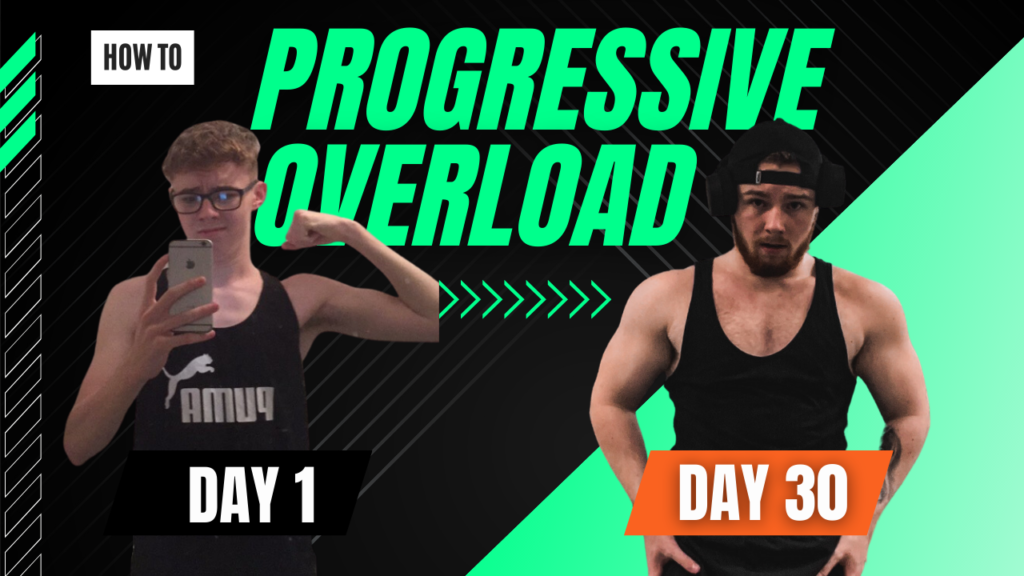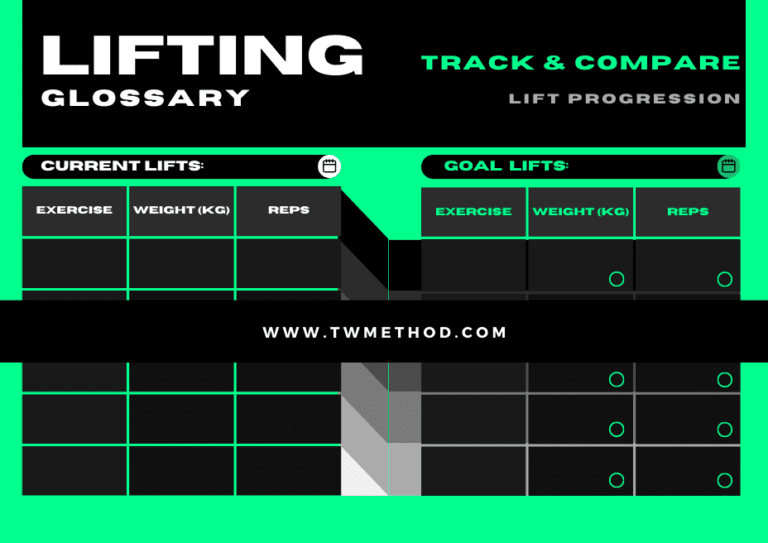Picture yourself making consistent progress in the gym, smashing pr’s, and transforming your physique. The key to achieving such gains lies in a fundamental principle called progressive overload!

So now you know the secret to increasing strength and muscle mass. What exactly is it? And how do we put it into action for the most optimal results in the gym?
Firstly this is the single most important aspect to lifting. If I were to be bestowed with the misfortune of being able to express only two words as a coach, it would undoubtedly be progressive overload.
Understanding Progressive Overload
Progressive overload, is what it says on the tin. It’s the process of progressively overloading the muscles with more stimulus which promotes muscle adaptation and growth. The process of simply getting better through increasing an aspect of your lift.
Including but not limited to enhancing the number of repetitions or sets performed, elevating resistance levels or tension via increased eccentric exertion, and shortening rest periods between sets. Seems easy right?
It is. The hard thing about it is achieving this every week consistently. This is what leads to muscle gain. The consistent accumulation of small gains across a long period. And that is the aim, to progressive overload every week in some shape or form to prevent frustrating plateaus.
This also puts an end to Arnolds rather bizarre claim of the need to shock the muscle. Muscles do not recognise the difference between a bicep curl or masturbating. It does however recognise stimulus.


Therefore we first and foremost want to invest and follow a structured programme for a set period of time to allow us to increase said stimulus. For the ultimate workout programmes see here.
Achieving the desired results is not as difficult as one may think, particularly with our proven methods. These secrets will be revealed in detail throughout this article, providing you with a step-by-step formula for success.
If you‘re willing to work hard in the gym, I can provide you with specific guidelines on what and when to increase certain elements. By following these instructions you can guarantee 4 inches of growth to your biceps.
Implementing Progressive Overload
1. Increase Resistance: Adding Weight, Because Muscles Need a Challenge!
Grab those iron plates and throw some weight about! When it comes to progressive overload, one of the classic techniques is simply slapping on more weight to the bar than you did the previous week. Have you ever seen someone with tooth picks for legs squat 4 plates?
But before you start loading the bar like Eddie Hall, remember to prioritise safety and good form. You can’t progress nothing with a torn pec muscle and a non-existent rotator cuff. If you start to abandon form to increase weight you are no longer progressively overloading.
Instead you are stupidly incorporating other muscles to lift the weight. Remember we want to increase stress to the muscle not increase the weight. The muscle only recognises stress not how many plates are on the bar.
Start small and gradually increase the load, allowing your muscles to adapt and grow stronger. Progression is a marathon, not a sprint!
2. Manipulate Repetitions and Sets: It's All About Reps, Reps, Reps!
Overlooked but underrated. This is the easiest most efficient way to achieve progressive overload. And when combined with techniques as shown later in the article, endless muscle growth is inevitable.
Remember, though, it’s not just about randomly jumping from rep scheme to rep scheme. You will want to follow a structured rep scheme and stay within.
For example, a programme will suggest 8-12 reps. select a weight that challenges you enough to reach muscle fatigue at around 8 repetitions. As your body adapts, gradually increasing the intensity by aiming for an additional repetition each week will promote progressive overload and continued progress in building strength.
3. Modify Rest Periods: To Rest or Not to Rest, That Is the Question!
Rest periods—the sweet relief between sets when you contemplate life, catch your breath, and wipe off the sweat from your forehead. But did you know that manipulating rest periods can make or break your progressive overload game?
By decreasing your rest time you in turn increase stress to the muscle as it has less time to recover. However I recommend keeping rest times consistent and manipulating other variables.
Adequate rest is imperative for both strength and hypertrophy training to allow you to attack your muscles at 100% every set. For heavy exercises in low rep ranges aim for 3-5 minute rest. And 2-3 minutes in higher rep ranges.
Remember progressive overload is the secret sauce that transforms your workouts from mundane to magnificent. So, embrace the challenge, crank up the intensity, and watch your muscles grow.
Keep pushing, keep lifting, and keep surprising yourself with the incredible progress you can make to become the ultimate you.
Tracking and Assessing Progress
1. Set Measurable Goals: Aiming for Greatness, One Goal at a Time!
When it comes to progressive overload, having clear, measurable goals is like having a treasure map to gains. It’s not enough to say, “I want to get stronger.” No, no, we need specific targets to conquer.
Whether it’s increasing your bench press by 10 pounds, adding an extra rep to your pull-ups, set goals that ignite your motivation and give you something tangible to strive for. Remember, big or small, each goal achieved is a stepping stone to the ultimate you!
Manifest your goals into reality by inputting them into our Ultimate lift tracker. A purpose built section for setting and comparing progress. Watch what once seemed like an impossible mountain to climb become a glorious view.
2. Tracking Progress: From Squiggly Lines to Glorious Victories!
Ah, the beauty of tracking progress – turning seemingly random numbers and scribbles into a roadmap of triumph! You wouldn’t drive blindfolded, would you? Well, the same goes for your fitness journey. Keep track of lifts, sets, reps, and rest periods like a meticulous detective collecting evidence.
Thankfully, we live in the age of technology, where mobile apps, spreadsheets, and the Ultimate lift tracker are at our disposal. Choose a tracking method that suits your style, and embrace the power of progress data. Witness firsthand how those numbers evolve into an upward trajectory of victory, proving that your efforts are paying off!
3. Recognizing Plateaus: Breaking Up with Plateaus, It's Not Me, It's You!
The dreaded plateau, the relationship equivalent of being stuck in the friend zone with your gains. It happens to the best of us, but fear not, for we shall rise above!
Plateaus occur when our bodies get too comfortable with the same old routine and our bodies adapt to the stimulus. This will not happen in 8 weeks. So stick to the plan.
However, if you feel progress has begun to slow on a certain exercise for an extended period of time, introduce new exercises, modify rep ranges, or switch up your training split. Keep your muscles on their toes, and watch those plateaus crumble like a house of cards.
How to optimally progressively overload?
Firstly you are going to want to download the ultimate lift tracker. This is an imperative tool to manage your progressive overload.
You can’t cheat yourself or slack off because numbers don’t lie. By tracking your lifts you know what lifted last week and what you have to beat this week. To really blow these numbers out of the water refer to our Ultimate Bulking Guide to optimise results.
After you have downloaded the ultimate lift tracker you will want to input your programme and fill out all aspects as shown below:
This is your starting point, a point that will be blown out the water using our methods. So how do we go about beginning to overload?
We are going to combine both the increase of reps and weight in order to optimally increase your overload. As previously highlighted each exercise should have a set rep range. We’ll use the previous example of 8-12.
We will start with 70kg for 3 sets of 8 reps. Next week, we aim to do the same weight for one more rep per set. Each following week, we’ll continue adding an additional rep until you hit 12 reps per set. At this point, we‘ll increase the weight slightly so that your reps go back down to 8 while maintaining proper form.
By consistently increasing intensity over time through this methodical process of progression, you can achieve impressive gains in both strength and size without risking injury from jumping too quickly into heavy weights or training volumes beyond what your body can handle safely and effectively.
However you will find that you will struggle to progressive overload on every single lift of the session. Therefore to solve this I chose to only progressively overload one target muscle group a session.
For example in a push pull legs split we train each day twice a week. Thus on the first push session I will choose to overload the chest. On the second push session I will overload the triceps. This allows for muscles to recover and operate at full capacity.
As a result in my personal PPL split this is the order which I will progressively overload.
Chest Legs Biceps Triceps Shoulders Back
This allows for muscles to recover from high stimulus and will also not impact other sessions of the week.
With this revolutionary method, you can bid farewell to stagnant progress and embrace steady and unexpected muscle development, all while reigniting your passion for working out.
SUBSCRIBE TO RECEIVE YOUR WEEKLY DOSE OF EXCELLENCE
Why not let greatness come to you with our weekly newsletter? Packed with expert methods and great deals to speed up your improvement!



